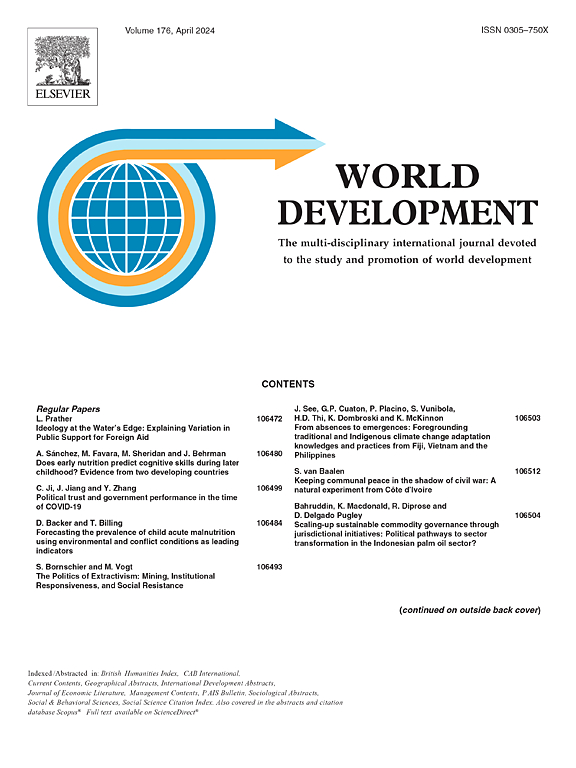Extraordinary African cities? Zipf’s law and the emerging African system of cities
IF 4.8
1区 经济学
Q1 DEVELOPMENT STUDIES
引用次数: 0
Abstract
This paper revisits the rank-size power law of urban hierarchies in Africa, with new analysis of the relationship between urban agglomeration, colonial legacies, and spatial economic inequalities. It explores urban patterns of spatial distribution of economic activity across Sub-Saharan Africa and finds evidence that Zipf’s law holds for African cities. Based on population panel data from Africapolis for 34 countries over the period 1960–2015 – it finds that the rank-size rule relationship has strengthened over time, with the statistically significant parameters converging closer to −1. The empirical evidence supports an inverted U-shaped relationship between the Zipf parameter and GDP per capita growth with different effects across groups of countries by colonial legacies (British versus French), income, and land size. These results are based on 2SLS and dynamic system GMM panel data quadratic estimations. The findings suggest an urban Kuznets bell-shaped curve, implying that economic growth may initially increase urban income inequalities, while reversing to reduce spatial income inequality with further GDP per capita growth. The African urban hierarchy – both nationally and region-wide – is evolving to the empirical regularities commonly observed elsewhere.
非凡的非洲城市?齐夫定律和新兴的非洲城市体系
本文回顾了非洲城市等级的等级-规模幂律,并对城市群、殖民遗产和空间经济不平等之间的关系进行了新的分析。它探索了撒哈拉以南非洲地区经济活动空间分布的城市模式,并找到了齐夫定律适用于非洲城市的证据。基于1960年至2015年期间34个非洲国家的人口面板数据,研究发现,等级-规模规则关系随着时间的推移而加强,统计上显著的参数趋近于- 1。经验证据支持Zipf参数与人均GDP增长之间的倒u型关系,其影响因殖民遗产(英国与法国)、收入和土地面积的不同而不同。这些结果是基于2SLS和动态系统GMM面板数据的二次估计。研究结果表明,城市呈库兹涅茨钟形曲线,这意味着经济增长最初可能会增加城市收入不平等,而随着人均GDP的进一步增长,空间收入不平等会减少。非洲的城市等级制度- -国家和区域范围- -正在演变成在其他地方普遍观察到的经验规律。
本文章由计算机程序翻译,如有差异,请以英文原文为准。
求助全文
约1分钟内获得全文
求助全文
来源期刊

World Development
Multiple-
CiteScore
12.70
自引率
5.80%
发文量
320
期刊介绍:
World Development is a multi-disciplinary monthly journal of development studies. It seeks to explore ways of improving standards of living, and the human condition generally, by examining potential solutions to problems such as: poverty, unemployment, malnutrition, disease, lack of shelter, environmental degradation, inadequate scientific and technological resources, trade and payments imbalances, international debt, gender and ethnic discrimination, militarism and civil conflict, and lack of popular participation in economic and political life. Contributions offer constructive ideas and analysis, and highlight the lessons to be learned from the experiences of different nations, societies, and economies.
 求助内容:
求助内容: 应助结果提醒方式:
应助结果提醒方式:


